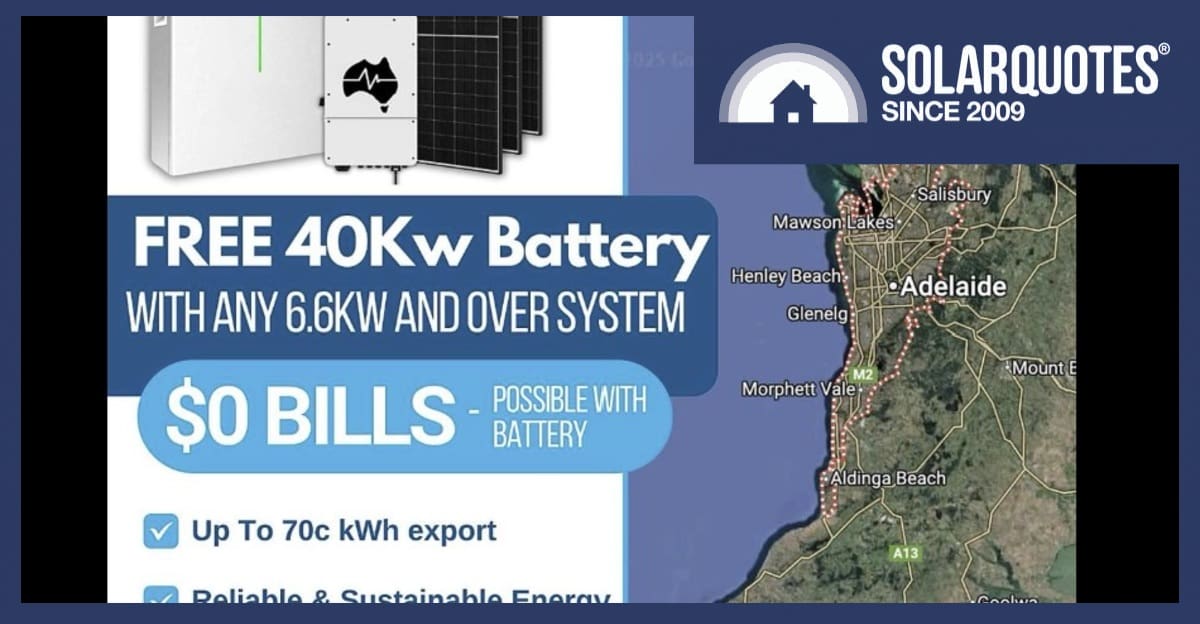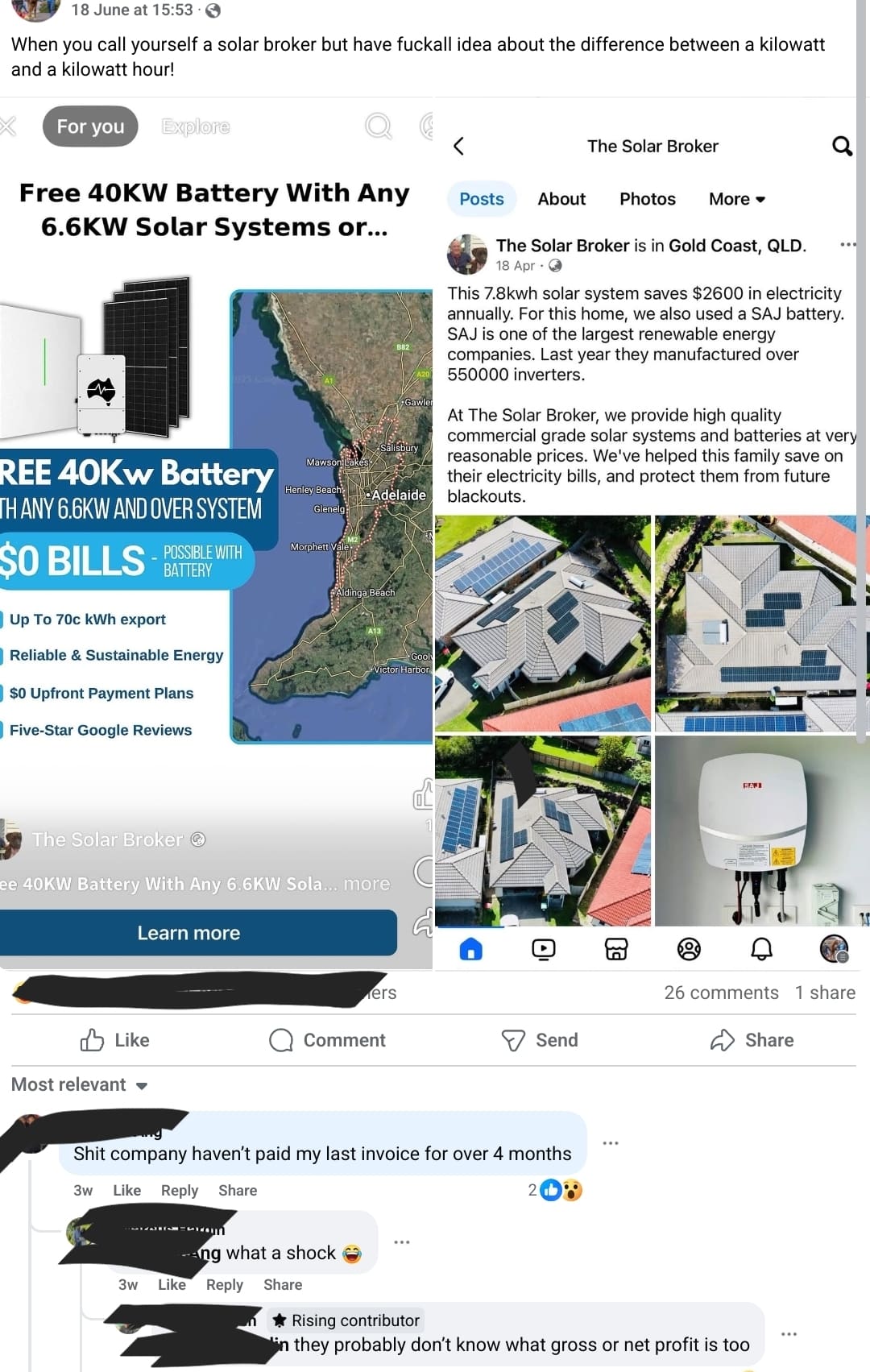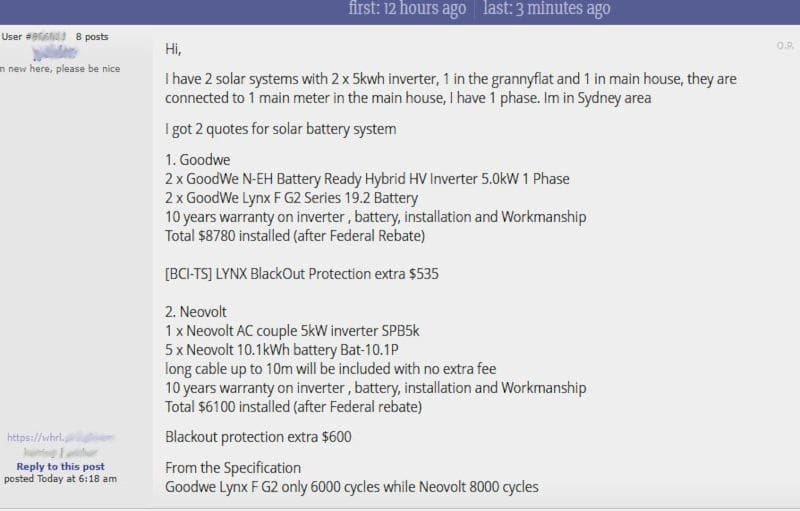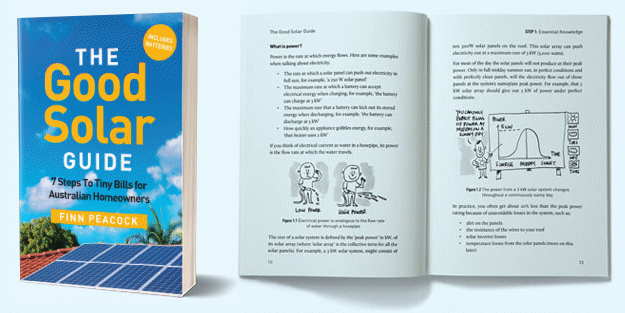 The launch of the battery rebate means there’s more work than ever for the industry. Instead of taking advantage of customers as happened with the solar rebate, installers should realise they now have the power to refuse to work with dodgy operators and poor quality brands.
The launch of the battery rebate means there’s more work than ever for the industry. Instead of taking advantage of customers as happened with the solar rebate, installers should realise they now have the power to refuse to work with dodgy operators and poor quality brands.
During the last 15 years of solar rebates, cheap gear and cheaper installs ran riot. We can’t let that cycle repeat.
This is our shot to do it right. While people are petrified that poor installation may lead to fires, I expect the hardware is actually pretty safe.
The real risk is that batteries are much more complex. Poor installs won’t burn down garages, but they’ll set fire to the energy industry credibility more broadly.
You see it in the comments section all the time. People with no technical understanding and a lot of anger will declare “iTs aLL a bIg SCAM!” based on their feelings.
Reputation Rehab
Having invested a large chunk of private and public money, Australians may find batteries bring them undone with much more mundane failures. As an industry, solar electricians need to invest the time to explain all the confusing, competing and infuriating details.
It’s said that solar salespeople are as well-trusted as those flogging used cars, which considering we’re dealing with new products under Australian Consumer Law is pretty ludicrous.
Simple wiring errors, software problems, hardware conflict will all cause grief. Combined with poor understanding of energy management by end users and opaque electricity retail deals, we’ll have a cornucopia of potential disappointment. With so many points of failure, it’s going to be difficult to avoid all the pitfalls.
Most long-term installers know what’s coming, it is after all the reason we call it the solarcoaster, but we need to be louder.

You might want to think twice about a solar company that doesn’t know the difference between kW and kWh.
The Blowflies Are Coming
As a qualified solar electrician, my phone is ringing every week with random solar retailers looking for new subcontract installers. The increasing regularity of these cold calls proves there’s no shortage of work.
I get them to email their rates to my @solarquotes.com.au email address, but amusingly, they are never bright enough to work out just who they’ve sent the terms they’re offering.
For subcontractors who have to run a vehicle, insure themselves for income and risk, maintain licences and spend time on maintaining qualifications, buy tools, cable & consumables, unsustainable pricing looks like this:
Standard installation (up to 6.6kW) – $1450 + GST
Additional capacity (beyond 6.6kW) – $55 per panel
Double storey installation – $150
Three-phase installation – $100
Additional roof plane – $80
Export control device – $150
GSD – $100
Extra inverter – $250
Steep roof installation – $200
Optimisers / Tilt frames / Micro inverters – $10 per panel
System removal – $10 per panel
System disposal – $10 per panel
Travel beyond 60km – $1 per km
Battery installation – $800
Battery backup – $250
How does this example break down?
- Removing panels pays 37% of the install rate, despite posing the same risk if you break a tile or drop one off the roof.
-Bear in mind new ones come well packaged, loaded by a forklift at the wholesaler.
– Even if you don’t have to worry about scratches, there’s arguably more work in manually packing and unloading used panels. - $150 won’t hire a cherry picker for a two-storey roof.
- Steep roofs can double the installation time
- Three-phase means twice as much AC cable is required
SAA-qualified people aren’t allowed to sign off more than two systems a day, so trying to smash out more jobs with more people will result in poor quality haste, not efficiency.
Regardless of which, I’m seeing the same rubbish products, the same predatory pricing, the same pressure from desperate sales companies who set up a new ABN last month to cash in while the going is good and the warranty claims are yet to pile up.
Say No to Rubbish
There’s going to be more battery work than most of us in the industry can handle, even though the Clean Energy Regulator has just loosened the rules a little to help clear the backlog of “ready to commission” work that’s been nearly complete for a month or two now.
- Many are urging their fellow electricians to use their freedom to choose work.
- Walk away from retailers who only care about volume.
- Stick to quality gear.
- Install it properly.
- Educate every customer you talk to.
That’s how we use this rebate to improve the whole electricity industry, not make it worse.
Why Sell Yourself And The Customer Short?
Just this week, I saw a flyer offering a 3kWh Alpha battery for $1200 fully installed, claiming it would “zero your power bill” if you “act now before the funding ends.”
That’s not even close to possible when an average Australian household uses 16 to 20kWh/day and the scheme is legislated out to 2030.
Explaining these things to the punters takes time, but it builds trust which is incredibly valuable.
Mass Letter Drops Lure In Pensioners
Mass-market letter box drops reach people with limited technical understanding and little money to spare.
Pensioners and low-income households, those who can least afford to be taken for a ride, will end up with poor-quality systems, poorly installed and poorly designed.
And it’s not new. Solar Battery Group and others have been doing this for years. Several customers a month show me these quotes, more appear on various social groups and that number is only going up.
What Can Electricians Actually Do About It?
It’s easy to vent, but what action can we take? What steps can others follow?
Here’s mine: I don’t touch cheap gear. I’ve refused to install a number of shiny new products that suddenly hit the market, even when the customer demands a particular brand, because I remember the Nedap Power Router and the fires it caused.
I don’t work for retailers who sell on price. I don’t install poorly. I say no to customers who insist they can’t afford what I recommend. I’ve played that game before and been thoroughly burnt, so I’d rather lose the job than install something I’m not sure will last.
Now I’m in the unique position of being able to write advice. I post on social media. I explain why it matters. Even if only a few people listen, that’s still worth something.
If someone’s going to buy a battery, they deserve to know what they’re getting into. Even if half will still go for the cheap option, it doesn’t mean we stop trying to help them, because it’s our tax money that’s being invested here too.
Let The Bad Operators Burn Out
Let the rubbish collapse under its own weight. Stand firm. Resist the temptation to soothe the hip pocket nerve with a short-lived bargain. If enough of us do, the worst operators will burn out.

While GoodWe is good value with a track record of 13 years Australian support, Neovolt is an Alpha in blue paint, imported by a company that’s already disappeared from Australia once, and now they’re back.
GoodWe is not only compatible with 6 different batteries, this design has 10kW of inverter and 40kWh of storage. The cheaper package only has a 5kW inverter, meaning it would need 10 continuous hours working flat out to fill the battery. It’s a stupid design.
And a warning to any installer selling gear from a brand-new company: if the gear you’re offering comes from a business younger than your toddler, ask yourself if you’re ready to explain that to a customer in five years when the thing fails.
Having used the federal battery incentive on a cheap system, can you as a consumer afford to pay full retail for a decent quality replacement? When the no-name inverter fails, or the bespoke battery dies and this particular model is now obsolete, what happens then?
For Installers Wanting To Help
I understand Solar Victoria, despite its failings, has helped drive out some of the dodgy operators. Yet this industry won’t be cleaned up by regulators. We’ve spent 15 years waiting for them, we’ll be waiting forever at the current rate.
Electricians have the power to turn this around, if they stop doing retailer installs for crap money. They have to charge what they’re worth. Run a sustainable business, not a charity. Battery customers are not only more demanding, they have more complex needs, so we must price in some after-sales support.
If a salesperson is out there selling 100 battery jobs, they still need a licensed electrician with SAA accreditation to get it done. Electricians have to start acting like it.
We’ve seen this before when the solar rebate launched. It’s déjà vu, and not in a good way. Let’s not sit back and watch it happen again.
For more on the federal battery rebate, read our regularly updated explainer page.

 RSS - Posts
RSS - Posts



Yes, my facebook feed is flooded with dodgy solar and battery adds, which i can pick easily thanks to my solar quotes education.
Mate of mine had a battery installed on Friday, he sent me a picture saying this doesnt look very big for the size he paid for – 19kwh. It is the same brand of batteries as mine, so I sent him a pick of mine which is a 19kwh stack, telling him it looks like his stack is at least 2 modules short.
So he asked the electrician installing it, he says it is only 10kwh of battery, that is what he is being paid to install.
My friend spent late Friday trying to get hold of the salesman with no luck, no idea if he has had any better luck today.
Solar Battery Group should be ashamed of themselves. I had a call from an 84-year-old, slightly confused and recently widowed customer that we installed a small PV system for in 2016. His bills now are approximately $117 per quarter.
He received ‘The letter’ and contacted them thinking it was a special offer, and they talked him into a 3kW inverter with 15kWhr’s of storage for around $7200.00. They talked him into paying a $119 deposit via credit card over the phone, then the full balance a few days later.
He rang me because they needed information off the existing system as well as photo’s etc. and only found my details by going through his wife’s files as she looked after this type of thing.
I had to tell him that they have screwed him over but as he is in his cooling off period, he should be able to exit the contract. As for getting his money back though, he will have a battle ahead of him. I will try to assist but there really isn’t many options available to him sadly.
you don’t get much lower than that.